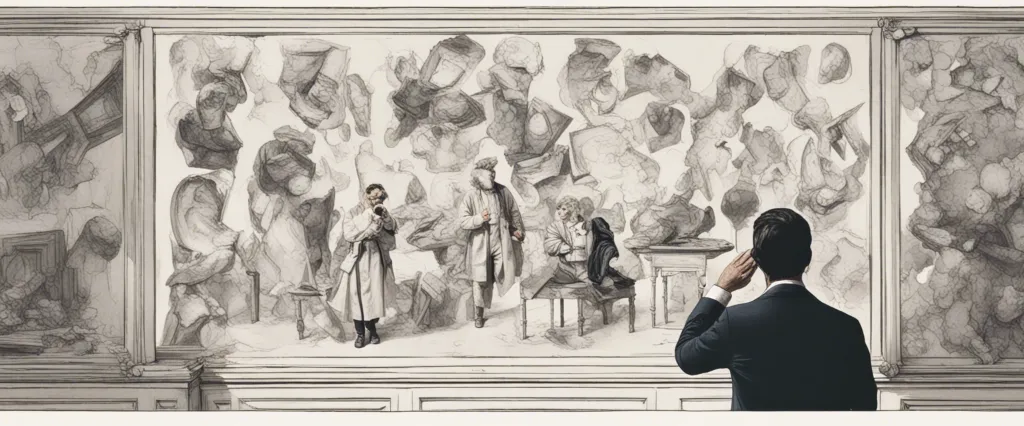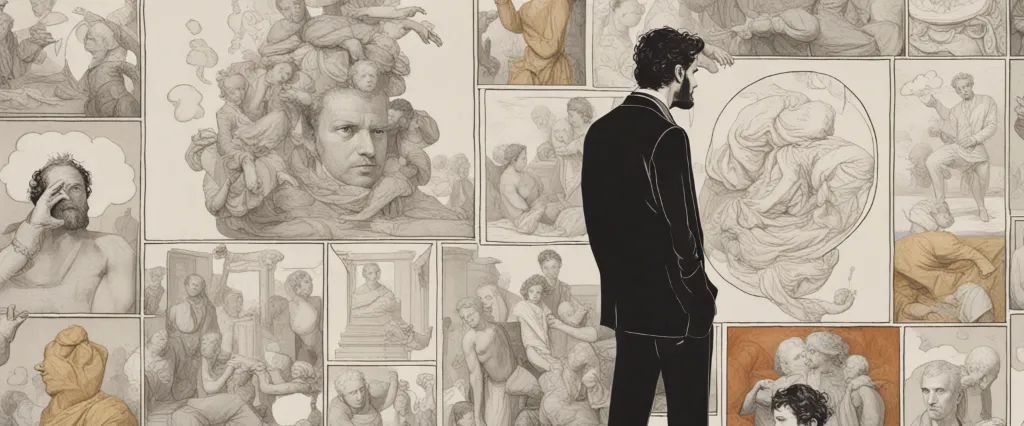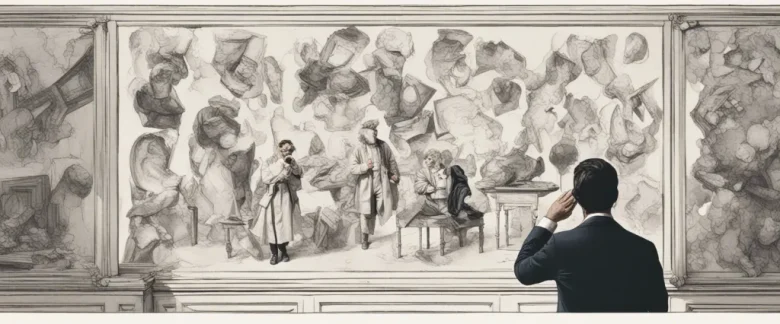
In “What Are You Looking At,” Will Gompertz delves into the captivating world of modern art, unraveling its history, significance, and perplexing nature. As an accomplished arts editor and critic, Gompertz possesses a remarkable ability to demystify art for the general public, shedding light on its often bewildering concepts and offering a refreshing perspective on its relevance today. With his wit and extensive knowledge, Gompertz invites readers on a thought-provoking journey through time, exploring the birth of modern art movements and the creative minds that challenged conventional norms.
Chapter 1: Art: A Brief History and Introduction
Chapter 1 of the book “What Are You Looking At” by Will Gompertz, titled “Art: A Brief History and Introduction,” provides an overview of the history of art and introduces key concepts and questions that will be explored throughout the book. Gompertz’s goal is to demystify art and make it accessible to everyone, regardless of their previous knowledge or interest in the subject.
The chapter begins with the acknowledgment that art has a reputation for being complicated, ambiguous, and exclusive. Gompertz challenges this perception by arguing that art is a fundamental part of the human experience and can be appreciated and understood by everyone. He emphasizes that art is not confined to traditional forms like painting and sculpture but can also encompass various mediums such as film, music, and even everyday objects.
Gompertz then takes the reader on a historical journey through art, from prehistoric cave paintings to modern developments. He highlights major art movements like the Renaissance and Impressionism, discussing their impact on the art world and society at large. This historical context helps to establish the significance of art and its ability to reflect and shape cultural attitudes.
Additionally, Gompertz poses thought-provoking questions throughout the chapter that aim to engage readers in thinking critically about art. For example, he asks, “What makes an artwork a masterpiece? Who decides?” These questions set the stage for deeper exploration into the subjective nature of art and the role of institutions and individuals in defining its value and meaning.
Overall, Chapter 1 of “What Are You Looking At” serves as an introduction to the book’s main themes, promoting a broader understanding and appreciation of art. Gompertz challenges the notion that art is an elitist domain, inviting readers to embrace their own perspectives and interpretations as valid and worthwhile.
Chapter 2: The Birth of Modern Art: Impressionism and Post-Impressionism
Chapter 2 of “What Are You Looking At” by Will Gompertz explores the birth of modern art through Impressionism and Post-Impressionism. The chapter delves into the groundbreaking artistic movements of the late 19th and early 20th centuries, giving readers an understanding of the historical and artistic context that led to the emergence of these revolutionary styles.
Gompertz begins by introducing the Impressionists, who rebelled against the established art world of their time. He explains that these artists sought to capture fleeting moments and sensory impressions of modern life, rather than creating detailed and polished artworks. Gompertz discusses the key figures of Impressionism, including Claude Monet and Pierre-Auguste Renoir, and how they used light, color, and brushwork to create a sense of immediacy and transience in their paintings.
Moving on to Post-Impressionism, Gompertz explores how this movement expanded upon the ideas of the Impressionists. He examines the works of artists such as Paul Cézanne, Vincent van Gogh, and Georges Seurat. Post-Impressionists experimented with bold colors, geometric forms, and expressive brushwork, pushing the boundaries of traditional representation even further.
Gompertz emphasizes the transformative impact of Impressionism and Post-Impressionism on the art world. He discusses how these movements challenged conventional artistic norms, shifting the focus from strict representation to personal expression and interpretation. Moreover, he highlights how these revolutionary styles paved the way for later modern art movements, influencing artists throughout the 20th century and beyond.
In summary, Chapter 2 explores the birth of modern art through Impressionism and Post-Impressionism, highlighting their rejection of convention and their groundbreaking approaches to capturing the fleeting nature of modern life. These movements laid the foundation for future artistic developments, forever altering the course of art history.
Chapter 3: The Avant-Garde Revolution: Cubism, Futurism, and Dadaism
Chapter 3 of “What Are You Looking At” by Will Gompertz explores the avant-garde artistic movements of Cubism, Futurism, and Dadaism, which emerged in the early 20th century and revolutionized the art world.
The chapter begins with an analysis of Cubism, pioneered by Pablo Picasso and Georges Braque. Gompertz explains that Cubism aimed to depict multiple viewpoints of an object simultaneously, breaking away from traditional representation. He discusses the importance of Cezanne’s influence on Cubism, as well as Picasso’s innovation in introducing collage and incorporating everyday objects into artworks. Gompertz highlights the revolutionary aspects of Cubism, emphasizing how it disregarded conventional artistic norms and paved the way for new artistic possibilities.
Moving on to Futurism, the author delves into the movement’s fascination with speed, technology, and the future. Led by Filippo Marinetti, Futurism celebrated modernity, rejecting the history and traditions of the past. Gompertz discusses the movement’s manifesto, which proclaimed the embrace of violence and war as a means to deconstruct and rebuild society. He acknowledges that Futurism had some success with its dynamic artwork and avant-garde ideas but criticizes them for their support of Fascism.
Lastly, the chapter explores Dadaism, an anti-art movement born out of frustration with the destruction of World War I. Gompertz describes the movement’s rejection of reason and logic, presenting absurd and nonsensical artworks. He explains that Dadaism aimed to challenge traditional notions of art and provoke thought. The author highlights key figures such as Marcel Duchamp and Tristan Tzara, who pushed the boundaries of art by presenting readymades and promoting chance-based creations.
Overall, Chapter 3 of “What Are You Looking At” provides an insightful summary of the Avant-Garde Revolution and the impact of Cubism, Futurism, and Dadaism on the art world. These movements shattered conventions, redefined the boundaries of art, and set the stage for further artistic developments in the 20th century.
Chapter 4: Surrealism and the Unconscious Mind

Chapter 4 of the book “What Are You Looking At” by Will Gompertz explores Surrealism and its relationship with the unconscious mind. Surrealism was an art movement that emerged in the early 20th century, originating in Europe but eventually gaining global recognition.
The chapter begins by emphasizing the importance of the unconscious mind to Surrealists. Gompertz explains how Sigmund Freud’s theories on psychoanalysis greatly influenced Surrealism, particularly the notion that our conscious minds are merely the tip of the iceberg, with the majority of our thoughts and desires hidden beneath the surface. Surrealists believed that by tapping into this subconscious realm, they could access greater creativity and express deeper truths about the world.
The chapter then delves into the life and work of key Surrealist figures such as Salvador Dalí and René Magritte. Dalí’s art, known for its bizarre and dreamlike imagery, is analyzed, highlighting his use of symbolism and exploration of the unconscious mind. Magritte’s fascination with the concept of perception and reality is also explored, with his famous painting “The Treachery of Images” serving as a prime example.
Gompertz explains how Surrealism was not constrained to visual art alone but also permeated literature, film, and theater. He examines the collaboration of Surrealist artists with playwrights and filmmakers, leading to the creation of groundbreaking works that challenged conventional narrative structures and invited audiences to explore their own unconscious minds.
Overall, this chapter illuminates how Surrealism was an artistic movement deeply rooted in the exploration of the unconscious mind. By pushing the boundaries of reality and tapping into their subconscious, Surrealist artists aimed to reveal deeper truths and engage audiences in a new and thought-provoking way.
Chapter 5: Abstract Expressionism: Emotion and Gesture in Art
Chapter 5 of “What Are You Looking At” by Will Gompertz delves into the movement known as Abstract Expressionism, which emerged in the United States in the mid-1940s and lasted until the early 1960s. This chapter explores how Abstract Expressionism revolutionized the art world through its emphasis on emotion and gesture.
Gompertz begins by explaining the societal and artistic context that gave birth to this movement. He highlights the psychological impact of World War II and the feeling of angst and uncertainty that permeated post-war America. Abstract Expressionism, he argues, aimed to capture those powerful emotions and express them through art.
The author then introduces the key artists associated with this movement, such as Jackson Pollock and Willem de Kooning, who broke away from traditional techniques and conventions. Their artworks were characterized by an emphasis on spontaneity, free expression, and the physical act of painting itself. Gompertz describes Pollock’s famous “drip paintings,” where he would let paint drip onto the canvas in a seemingly chaotic yet purposeful manner.
Furthermore, Gompertz explores the impact of Abstract Expressionism on the art world. He explains how influential art critic Clement Greenberg championed this movement and defined its core principles. Abstract Expressionism, according to Greenberg, represented the purest form of art, divorced from representation and narrative.
The chapter also discusses the division within Abstract Expressionism between color field painters, such as Mark Rothko, who focused on large swaths of color, and gestural painters, like Franz Kline, who utilized bold brushstrokes. Gompertz underlines the diversity within the movement, as artists approached their work with unique styles and intentions.
In conclusion, Chapter 5 provides a comprehensive overview of Abstract Expressionism and its central tenets of emotion and gesture. Gompertz effectively captures the essence of this movement, highlighting its revolutionary nature and its enduring impact on the art world.
Chapter 6: Pop Art and the Influence of Popular Culture
Chapter 6 of “What Are You Looking At” by Will Gompertz explores the emergence and influence of Pop Art in relation to popular culture. Gompertz delves into the origins and evolution of Pop Art, examining key artists and their works that captured the spirit of the movement.
Pop Art emerged in the mid-1950s, fueled by a desire to challenge and disrupt the conventional notions of art. This movement sought to bridge the gap between high and low culture, embracing elements of popular culture such as advertisements, comics, and everyday objects. Artists like Andy Warhol, Roy Lichtenstein, and Claes Oldenburg emerged as important figures in the Pop Art movement, each employing unique techniques and subject matters to convey their ideas.
Warhol, perhaps the most iconic figure associated with Pop Art, utilized mass production techniques to create his artworks. His paintings of Campbell’s soup cans and Marilyn Monroe showcased his fascination with consumerism and celebrity. Lichtenstein, on the other hand, replicated the style of comic books by using Ben-Day dots and bold lines in his paintings, highlighting the graphic nature of pop culture. Oldenburg experimented with sculpture, creating colossal soft sculptures of ordinary objects like hamburgers and typewriters, blurring the lines between art and everyday life.
Gompertz also explores the impact of Pop Art beyond the art world. He discusses how this movement became closely entwined with popular culture and mass media, making its way into fashion, music, and film. The influence of Pop Art extended to music album covers, fashion designs, and even the famous banana image on the cover of The Velvet Underground’s debut album.
In conclusion, Chapter 6 focuses on the rise of Pop Art and its profound influence on popular culture. Gompertz analyzes the motives and techniques of prominent artists, examining their diverse approaches to capturing the essence of consumerism and everyday life. The chapter highlights the way in which Pop Art transcended the boundaries of the art world and permeated various aspects of popular culture, leaving an indelible mark on contemporary society.
Chapter 7: Conceptual Art and the Power of Ideas
Chapter 7 of “What Are You Looking At” by Will Gompertz delves into Conceptual Art and the Power of Ideas. Gompertz explores how the art world gradually shifted its focus from traditional mediums to the conceptual nature of art. Conceptual art rejects the notion that art needs to be a physical object and places emphasis on the idea or concept behind the artwork instead.
The chapter begins by discussing the emergence of Conceptual Art in the late 1960s, with artists like Marcel Duchamp and the Dadaists playing a significant role in laying its foundations. Gompertz explains how Conceptual Art challenged traditional artistic boundaries and asked audiences to engage with art in new ways. He highlights how artists such as Sol LeWitt, Lawrence Weiner, and Joseph Kosuth used language and text as their primary means of artistic expression, emphasizing the idea rather than the aesthetic.
Furthermore, Gompertz discusses the controversies surrounding Conceptual Art, with critics arguing that it lacks skill or craftsmanship and is often difficult to understand. However, he counters these arguments by explaining that Conceptual Art requires viewers to critically engage with the idea behind the artwork rather than merely relying on visual cues.
Gompertz also explores the artistic movement’s influence beyond the art world, particularly in architecture and design. He discusses how the ideas of Conceptual Art have led to the development of innovative spaces and structures that challenge our traditional perceptions of what constitutes art.
In conclusion, Chapter 7 of “What Are You Looking At” delves into the rise of Conceptual Art, its rejection of traditional artistic mediums, and emphasizes the power of ideas within the art world. It highlights how Conceptual Art has pushed the boundaries of artistic expression and challenged viewers to engage with ideas rather than relying solely on visual aesthetics.

Chapter 8: Contemporary Art: Exploring Diversity and New Forms of Expression
Chapter 8 of “What Are You Looking At” by Will Gompertz explores the contemporary art scene and the diversity of expression found within it. Gompertz emphasizes how this era has brought about a wide range of new forms of artistic expression, challenging traditional ideas and pushing boundaries.
The chapter begins by discussing the impact of technology on contemporary art. Gompertz highlights how digital media has revolutionized artistic practice, allowing artists to express themselves in previously unimaginable ways. He delves into the rise of digital art, video installations, and interactive pieces that engage the audience in a different and more immersive manner. These cutting-edge techniques have given artists the freedom to experiment and create art that questions conventional notions of the medium.
Another theme explored in this chapter is identity as a central focus in contemporary art. Gompertz mentions how artists from different cultural backgrounds are now gaining recognition, and their work often reflects their personal experiences and struggles. The art of these diverse voices allows for a more inclusive conversation on race, gender, and sexuality.
Gompertz also discusses the controversial aspect of contemporary art, including provocative and controversial installations that challenge societal norms and preconceived ideas. He examines the controversy surrounding Damien Hirst’s work, specifically his inclusion of animal corpses in his pieces, as well as Tracey Emin’s infamous bed, which sparked debates about what constitutes art.
In summary, Chapter 8 of “What Are You Looking At” explains how contemporary art has embraced new forms of expression through the use of digital media, interactive installations, and the exploration of identity. Artists today are challenging traditional notions of art and pushing boundaries, resulting in a diverse and thought-provoking art scene that invites different perspectives and encourages discussion.
After Reading
In conclusion, “What Are You Looking At” by Will Gompertz provides a comprehensive exploration of art history, delving into its various forms, movements, and key figures. Gompertz’s accessible and engaging style makes complex artistic concepts approachable for both art enthusiasts and novices alike. This book highlights the ever-evolving nature of art and encourages readers to broaden their perspectives on what constitutes art. With thought-provoking analyses and insightful anecdotes, Gompertz successfully conveys the power of art to shape our society and challenge our perceptions. Overall, “What Are You Looking At” is a valuable resource for anyone seeking to deepen their understanding and appreciation of the art world.
1. The Agony and the Ecstasy by Irving Stone: This gripping historical novel offers a vivid portrayal of the life and artistic journey of Michelangelo Buonarroti. Irving Stone’s meticulous research and storytelling skills bring to life the Renaissance era and the struggles, triumphs, and inner turmoil of one of the greatest artists of all time.
2. Wall and Piece by Banksy: Filled with stunning and thought-provoking street art, this book showcases the anonymous and elusive artist Banksy’s most iconic pieces. From politically charged graffiti to clever and satirical artworks, Wall and Piece offers a glimpse into the rebellious and eye-opening world of street art that challenges societal norms.
3. Mr. Wilson’s Cabinet Of Wonder by Lawrence Weschler: Drawing inspiration from the curious and eccentric collections of cabinets of curiosities, Lawrence Weschler chronicles the remarkable journey of David Wilson, the founder of the Museum of Jurassic Technology in Los Angeles. This engrossing book delves into the strange and captivating world of obscure artifacts, eccentric collectors, and the power of imagination.
4. The Private Lives of the Impressionists by Sue Roe: Offering an intimate look into the lives and relationships of the Impressionist artists, this book provides a fascinating blend of personal stories, artistic struggles, and social dynamics of the late 19th-century art scene. Sue Roe’s engaging narrative sheds light on the complex lives behind some of the most celebrated works in art history.
5. The Story of Art by E.H. Gombrich: Considered a classic in the field of art history, this comprehensive and accessible book takes readers on a journey through the history of art, from prehistoric cave paintings to modern masters. E.H. Gombrich’s engaging storytelling and insightful analysis make this book an essential resource for art enthusiasts, students, and anyone interested in exploring the evolution of art across time and cultures.




Comments
I must say, as a lot as I enjoyed reading what you had to say, I couldnt help but lose interest after a while. Its as if you had a wonderful grasp on the subject matter, but you forgot to include your readers. Perhaps you should think about this from far more than one angle. Or maybe you shouldnt generalise so considerably. Its better if you think about what others may have to say instead of just going for a gut reaction to the subject. Think about adjusting your own believed process and giving others who may read this the benefit of the doubt.